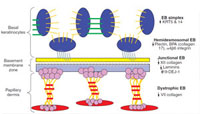
Are there hereditary diseases of the BMZ and dermis that cause blistering and damage to the skin? Yes. There is a complex group of inherited diseases in which the skin is friable and bullous lesions occur, often with subsequent scarring. The two subgroups within this group are junctional epidermolysis bullosas (JEBs) and dystrophic epidermolysis bullosas (DEBs). Like the EBS diseases, which affect the epidermal layers, these diseases occur because the vital structural elements of the BMZ and dermis are missing, causing the skin to separate easily and blister. In JEBs, the separation occurs within the lamina lucida (LL) of the BMZ. Decreased amounts or abnormalities in the LL components, such as laminins I and V, 19-DEJ-1 protein, XII collagen, plectin, XVII collagen (bullous pemphigoid antigen) and alpha 4 beta 6 integrin have been identified in this group.
In the DEB group, separation occurs below the BMZ in the dermal layer, and a decreased amount or absence of type VII collagen has been noted. As a rule, the deeper in the skin the separation occurs, the more severe the clinical picture with increased scarring and loss of function. DEB patients typically have severe deforming scars and decreased life span (see Fig. 1-4). | ||
© 2024 Skin Disease & Care | All Rights Reserved.